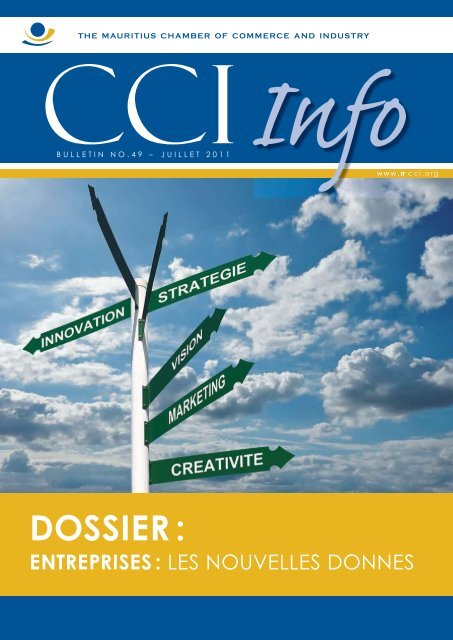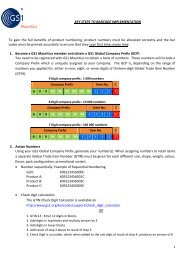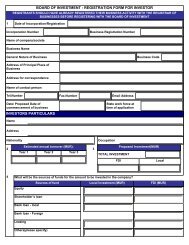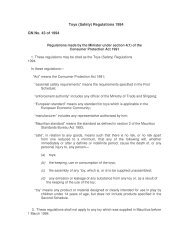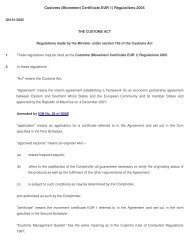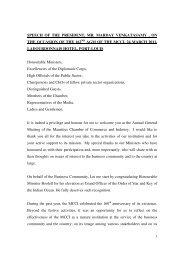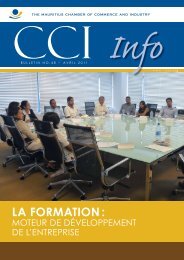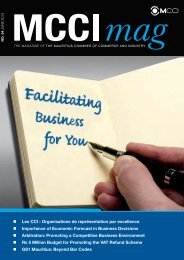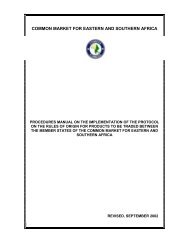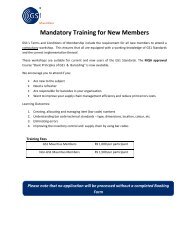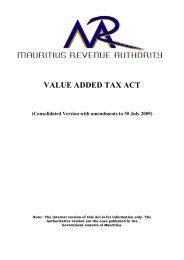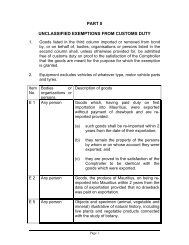dossier - The Mauritius Chamber of Commerce and Industry
dossier - The Mauritius Chamber of Commerce and Industry
dossier - The Mauritius Chamber of Commerce and Industry
Create successful ePaper yourself
Turn your PDF publications into a flip-book with our unique Google optimized e-Paper software.
BULLETIN NO.49 – JUILLET 2011<br />
DOSSIER :<br />
ENTREPRISES : LES NOUVELLES DONNES
SOMMAIRE<br />
2<br />
5<br />
14<br />
16<br />
18<br />
18<br />
20<br />
22<br />
Edito<br />
Dossier – Entreprises : Les nouvelles donnes<br />
6<br />
8<br />
10<br />
12<br />
La stratégie du succès<br />
CSR : Integrating Strategy <strong>and</strong> Philosophy<br />
Le Pari de l’innovation<br />
Interview<br />
Exports Trends 2005 – 2010<br />
Launching <strong>of</strong> Tripartite FTA Negotiations<br />
<strong>Mauritius</strong> – Singapore : A new era in the economic cooperation<br />
7e Forum Economique des Iles de l’Océan Indien<br />
India <strong>and</strong> <strong>Mauritius</strong> to consolidate their economic ties<br />
TTR Light Services open to shops under the deferred duty <strong>and</strong> Tax Scheme<br />
En Couverture<br />
Quelle stratégie adopter pour réussir<br />
les changements au sein d'une entreprise ?<br />
Le choix d'une stratégie dépend<br />
essentiellement de la position dans<br />
laquelle évolue une organisation.<br />
Le <strong>dossier</strong> de ce numéro, consacré<br />
à la stratégie "Entreprise" nous apporte<br />
quelques éléments de réponse.<br />
CCI Info<br />
Bulletin publié par:<br />
<strong>Mauritius</strong> <strong>Chamber</strong> <strong>of</strong> <strong>Commerce</strong> <strong>and</strong> <strong>Industry</strong><br />
3, rue Royale – Port Louis.<br />
Tél : (230) 208 33 01 • Fax : (230) 208 0076<br />
E-mail: mcci@intnet.mu • www.mcci.org<br />
CCI INFO BULLETIN NO. 49 JUILLET 2011 1
2<br />
EDITO<br />
QUAND L’AFRIQUE S’ÉVEILLERA<br />
Mahmood Cheeroo – Secrétaire Général<br />
CCI INFO BULLETIN NO. 49 JUILLET 2011<br />
Le livre d’Alain Peyrefi tte, ‘Qu<strong>and</strong> la Chine s’éveillera’,<br />
sorti en 1973, était certes visionnaire. La Chine est<br />
aujourd’hui deuxième puissance économique mondiale<br />
et devrait logiquement ravir la première place aux<br />
Etats-Unis dans moins de 20 ans.<br />
L’organisation impeccable, coup sur coup des derniers Jeux<br />
Olympiques et de l’Exposition Universelle de Shanghai, où<br />
les athlètes et le savoir faire chinois ont brillé de mille feux, a<br />
démontré que la Chine est devenue bien plus que la plus gr<strong>and</strong>e<br />
usine du monde.<br />
Mais comme le futur ne peut jamais être écrit au présent, les<br />
voies qui mènent aux gr<strong>and</strong>es transformations sociétales, ne<br />
sauraient être réduites aux recettes du passé. Ainsi qui aurait<br />
pu imaginer que le facteur clé du succès de la Chine allait être<br />
une lecture très particulière de la dialectique marxiste, l’unité<br />
des contraires s’illustrant par une cohabitation communisme/<br />
capitalisme, le fameux ‘un pays, deux systèmes’, inauguré par<br />
un certain Deng Xiao Ping ? De quoi faire retourner Marx et Mao<br />
dans leurs tombes !<br />
La transformation remarquable de la Chine et, dans une moindre<br />
mesure, les avancées de certains autres pays qu’on croyait<br />
condamnés au sous-développement (en particulier l’Inde), ont<br />
remis le projecteur sur l’Afrique.<br />
L’Afrique peut-elle s’éveiller ?<br />
Les rêves des ‘Etats Unis d’Afrique’ des premiers leaders historiques<br />
africains (Nkrumah, Nyerere, …) ont vite tourné en cauchemar,<br />
qu<strong>and</strong> la plupart des Etats nouvellement indépendants<br />
se sont égarés sur les sentiers de la perdition (socialisme à la<br />
soviétique, dictatures militaires, apartheid, guerre tribales, …).<br />
Une génération plus tard c’est un continent, qui malgré les avancées<br />
de quelques pays, se retrouve en marge du développement<br />
économique mondial. Ni les remèdes de cheval du FMI et de la<br />
Banque Mondiale, appelés à son chevet, ni les nouvelles initiatives<br />
purement africaines (‘African Rennaissance’ de Thabo Mbeki et<br />
le NEPAD) n’ont permis de vaincre le signe …africain !
Alors que tout semblait indiquer qu’encore une fois l’Afrique<br />
allait rater le train de gr<strong>and</strong>es transformations économiques<br />
et sociétales, cette fois tiré par la globalisation, elle se retrouve,<br />
par un curieux concours de circonstances que seule<br />
l’Histoire a le secret, au centre de gr<strong>and</strong>s défi s auxquels le<br />
monde se trouve confronté.<br />
D’abord, la croissance mondiale, dopée par le dynamisme<br />
des pays émergents, s’est heurtée au renchérissement des<br />
matières premières et de l’énergie. L’Afrique, en tant que<br />
l’une des premières sources de nombreuses matières premières,<br />
surtout minérales, devient un élément incontournable<br />
par alimenter la croissance mondiale. En plus, jamais<br />
dans son histoire récente on a découvert autant de réserves<br />
d’énergies fossiles en Afrique que pendant les dernières<br />
années. De nouveaux gisements de pétrole, de gaz et de<br />
charbon ont été identifi és, avec certains déjà en exploitation,<br />
en Afrique de l’Ouest, Afrique Centrale et Méridionale.<br />
Ensuite la crise alimentaire de 2008 a mis en exergue les<br />
limites actuelles de la production alimentaire mondiale avec<br />
une population ne dépassant pas les 7 milliards. La perspective<br />
d’une population de 10 milliards à nourrir à l’horizon<br />
de 2100 pose d’énormes défi s. Encore une fois on constate<br />
que l’Afrique détient une des clés de ce problème, étant<br />
le continent ayant le plus de terres arables non cultivées<br />
ou sous-exploitées.<br />
L’autre défi auquel le monde se trouve confronté est le<br />
vieillissement de la population. Les pays développés ressentent<br />
déjà les effets du phénomène. La Chine, avec sa politique<br />
d’un enfant par famille pendant plusieurs décennies<br />
et d’autres pays émergents n’y échapperont pas dans un<br />
proche avenir. L’Afrique avec son milliard d’habitants a la<br />
population la plus jeune de tous les continents. Cela représente<br />
un avantage certain.<br />
Et puis il y a le changement climatique. On savait que l’Afrique<br />
avec ses forêts tropicales avait un atout certain pour contribuer<br />
à la lutte contre le changement climatique. Mais la nouvelle<br />
quête d’énergies renouvelables est venue nous rappeler<br />
l’énorme potentielle de l’Afrique dans la matière. Rappelons<br />
seulement que l’implémentation du projet hydro-électrique<br />
EDITO<br />
d'Inga, en République Démocratique du Congo, suffi rait à<br />
lui seul de fournir tout le continent en énergie électrique,<br />
avec un excédent pouvant théoriquement être exporté sur<br />
l’Europe. Et sur un site identifi é par l’Agence Internationale<br />
de l’Energie dans le désert du Sahara, des installations photovoltaïques<br />
permettraient de générer de l’énergie en deçà<br />
des besoins de toute la planète !<br />
La gouvernance politique a été et reste le maillon faible de ce<br />
cercle vertueux qui se dessine. Mais encore une fois des progrès<br />
notables ont été accomplis. En Afrique Sub-Saharienne,<br />
grâce à la pression des pairs qui ont mis en place des régimes<br />
démocratiques, la stabilité politique gagne du terrain. En<br />
Afrique du nord, le ‘printemps arabe’, est venu balayer toute<br />
une région fi gée dans une gouvernance autocratique depuis<br />
des décennies. Même s’il est trop tôt pour tirer des conclusions,<br />
tous ses boule versements pourraient marquer un<br />
nouveau départ pour la gouvernance politique du continent.<br />
Enfi n la gouvernance économique. Même si elle a souffert<br />
de la gouvernance politique, la performance économique<br />
s’est globalement améliorée ces dernières années. L’Afrique<br />
a connu une meilleure croissance que toutes les régions du<br />
monde, sauf l’Asie bien sûr, avant, pendant et après la Gr<strong>and</strong>e<br />
Crise Mondiale. D’ailleurs le FMI prévoit une croissance supérieure<br />
à 5 % pour les prochaines années. En plus l’intégration<br />
économique du continent s’accélère. La plus récente et<br />
marquante initiative a été le lancement en juin dernier, par le<br />
Président Zuma en Afrique du Sud, des négociations pour la<br />
mise en place de la zone de Libre Echange Tripartite, la plus<br />
gr<strong>and</strong>e en Afrique, composée de 26 pays s’étendant du Caire<br />
au Cape Town, avec plus de 600 millions d’habitants. On n'a<br />
jamais été plus proche du rêve d’intégration économique de<br />
l’Afrique, tel qu’il est contenu dans le Traité d’Abuja.<br />
Il y a là tous les éléments d’un véritable éveil. Les gr<strong>and</strong>es<br />
puissances économiques y apportent un intérêt nouveau et<br />
développent chacune leur politique africaine. L’Ile Maurice,<br />
qui ambitionne d’être le pont entre l’Asie et l’Afrique doit<br />
consacrer plus d’énergie et de ressources à mettre en place<br />
une véritable politique africaine. ■<br />
CCI INFO BULLETIN NO. 49 JUILLET 2011 3
DOSSIER<br />
ENTREPRISES : LES NOUVELLES DONNES<br />
LA STRATÉGIE DU SUCCÈS<br />
NICOLAS DEVILLE – Chargé de cours au Centre d’Etudes Supérieures<br />
CORPORATE SOCIAL RESPONSIBILITY :<br />
INTEGRATING STRATEGY AND PHILOSOPHY<br />
LUVNA ARNASSALON – Analyst, Communications <strong>and</strong> Promotion Division<br />
LE PARI DE L’INNOVATION<br />
BARLEN PILLAY – Manager, Legal <strong>and</strong> Business Facilitation Division<br />
INTERVIEW<br />
MR. NAVIND GUNNOO – Directeur de la Société Luximon Gunnoo<br />
CCI INFO BULLETIN NO. 49 JUILLET 2011 5
6<br />
DOSSIER<br />
LA STRATÉGIE DU SUCCÈS<br />
Nicolas Deville – Chargé de cours au Centre d’Etudes Supérieures<br />
La stratégie du succès. Toutes les entreprises<br />
recherchent le succès. Mais dans un monde de<br />
plus en plus globalisé où les entreprises sont<br />
ballotées par un environnement en perpétuel<br />
mouvement et marqué par une gr<strong>and</strong>e instabilité ;<br />
la succession de crises économiques et fi nancières, les<br />
catastrophes écologiques, les ruptures technologiques<br />
liées aux accélérations considérables des innovations<br />
des NTIC, la pression concurrentielles exacerbées, il n’est<br />
guère évident pour l’entreprise et plus encore pour les<br />
hommes et les femmes qui la composent de conserver<br />
le sens de l’action, le goût de la performance, le plaisir<br />
de l’action collective et la fi erté de la réussite. Dans ce<br />
cas, de quel succès parlons-nous ? Le succès peut-il n’être<br />
construit que sur la base unique d’une stratégie à forte<br />
exigence de performance fi nancière ? Comment défi nir<br />
une stratégie viable permettant de pérenniser l’entreprise<br />
en conciliant les intérêts de l’individu, de la société<br />
et de la planète, dans un monde qui se révèle à la fois de<br />
plus en plus complexe et interrelié.<br />
Mutatis mut<strong>and</strong>is qu’est-ce que le succès ? Quel le lien entre<br />
stratégie et succès, et en pratique comment décliner la stratégie<br />
et le management.<br />
Du succès…<br />
Si pour le pr<strong>of</strong>ane le succès peut être défi ni comme un dénouement<br />
ou un résultat heureux à un événement ou une situation<br />
donnée, le succès d’une organisation ; qu’elle soit entreprise,<br />
administration publique ou organisation à but non lucratif,<br />
s’articule sur trois dimensions :<br />
• le succès compétitif,<br />
• le succès fi nancier,<br />
• le succès social.<br />
CCI INFO BULLETIN NO. 49 JUILLET 2011<br />
Ces trois dimensions étant interdépendantes car elles agissent<br />
et interagissent entre elles grâce à des circuits de renforcement<br />
qui les lient.<br />
Figure 1. Les liens entre les trois dimensions<br />
du succès d’une organisation.<br />
SUCCÈS<br />
COMPÉTITIF<br />
SUCCÈS<br />
FINANCIER<br />
SUCCÈS SOCIAL<br />
L’organisation cherche le succès compétitif pour obtenir des<br />
ressources qu’elle emploie dans la formulation d’une <strong>of</strong>fre<br />
aux interlocuteurs sociaux, c.-à-d., les parties prenantes qui<br />
fournissent les ressources critiques pour la survie durable<br />
de l’organisation. Dans cette optique l’utilisation des outils<br />
développés par M. PORTER s’avèrent particulièrement utiles<br />
pour mesurer l’intensité concurrentielle dans un contexte de<br />
segmentation stratégique. En effet cette analyse permet de<br />
dégager les cinq forces concurrentielles qui peuvent infl uer<br />
sur les facteurs-clés de succès des activités de l’entreprise :
• l’intensité de la compétition entre<br />
les entreprises du secteur ;<br />
• le pouvoir de négociation des clients<br />
et leur position de force ;<br />
• le pouvoir de négociation des fournisseurs<br />
et leur position de force ;<br />
• la menace d’arrivée de produits ou<br />
de procédés de substitutions ;<br />
• les nouveaux entrants possibles qui<br />
peuvent déstabiliser la pr<strong>of</strong>ession.<br />
A ces cinq forces nous rajouterons celle de l’Etat au travers la<br />
modifi cation du cadre juridique ou réglementaire pouvant<br />
modifi er le jeu concurrentiel sur un secteur d’activité.<br />
Comprenons par facteurs-clés de succès, ces éléments (accès<br />
aux matières premières, maîtrise technologique, exigence des<br />
prospects, etc.) qu’une entreprise doit absolument maîtriser<br />
pour être reconnue et acceptée par toutes les parties-prenantes<br />
sur un secteur d’activité bien défi ni, aussi appelé DAS, sous<br />
peine d’échec. A terme, le but étant de maîtriser ses ressources<br />
et de développer des compétences qui permettent à l’entreprise<br />
de se démarquer durablement des rivaux, en terme de prix et<br />
de différenciation, sur son marché lui conférant ainsi un avantage<br />
concurrentiel.<br />
Tant le succès compétitif que le succès social permettent le succès<br />
fi nancier. Ce dernier va à son tour permettre à l’entreprise de se<br />
donner les moyens (en termes de ressources) de ses ambitions.<br />
La recherche d’une stratégie…<br />
Dans un milieu dynamique, la recherche d’une stratégie pour<br />
atteindre ce succès tridimensionnel comporte toujours de<br />
l’innovation stratégique ou entrepreneuriale (Coda, 1988),<br />
c’est cette inventivité managériale qui permet d’exploiter des<br />
ressources encore non valorisées pouvant donner lieu aux avantages<br />
concurrentiels. La durabilité du succès de l’organisation<br />
implique alors un double apprentissage : d’un coté, la consolidation<br />
de la stratégie courante et de l’autre la recherche en<br />
permanence de nouvelles formules. Autrement dit, la stratégie<br />
se doit aujourd’hui d’être développée non seulement dans une<br />
vision énoncée mais aussi d’une façon évolutive.<br />
Les défi nitions de la stratégie d’entreprise sont nombreuses. En<br />
général la stratégie correspond à l’ensemble de décisions de<br />
long terme prises par l’entreprise pour atteindre ses objectifs<br />
compte tenu de ses ressources et de son environnement. Si ces<br />
décisions concernent l’ensemble de l’entreprise et portent sur<br />
la gestion du portefeuille d’activités nous parlons de stratégie<br />
générale ou corporate. S’il s’agit de choix stratégiques au niveau<br />
des domaines d’activités nous parlons de stratégie d’activité ou<br />
business. A noter que s’il existe des états de relations complémentaires<br />
entre plusieurs domaines d’activités stratégiques à<br />
l’intérieur d’un portefeuille qui peuvent engendrer un avantage<br />
concurrentiel, nous parlons dans ce cas d’adéquation stratégique<br />
(strategic fi t), notion proche de la synergie.<br />
Pour revenir à la notion de succès, prenons la défi nition de Morin<br />
(1984) : la recherche d’un maximum de certitude pour conduire<br />
l’action dans un milieu complexe. Ici le sujet est l’entreprise ou<br />
l’organisation qui est lui-même pluriel et complexe. Ainsi la stratégie<br />
a pour but le succès d’un sujet complexe dans un milieu qu’il<br />
perçoit comme étant complexe.<br />
Se donner les moyens de sa réussite...<br />
Malgré cette relative complexité, la défi nition d’une stratégie<br />
n’est pas toujours ce qu’il y a de plus ardu, le défi pour l’entreprise<br />
consiste à décliner ou à exécuter cette stratégie. Il s’agit<br />
ici de réconcilier la vision et l’intendance. Si cette dernière n’est<br />
pas au service de la vision, toute l’organisation s’en voit pénalisée<br />
(Napoléon, qui ne manquait pas de vision n’avait emporte<br />
qu’un seul atlas de la Russie en 1812). Plus concrètement, la<br />
meilleure stratégie peut échouer car, sur le terrain, des managers<br />
ne l’ont pas comprise ou ont effectué des choix en contradiction<br />
avec ceux des autres membres de l’organisation. De plus, depuis<br />
Cyert et March (1963), nous savons que les organisations n’ont<br />
pas de but, mais que seul les individus qui la composent en ont,<br />
le travail du manager est alors d’établir une cohérence entre les<br />
différentes aspirations. Ainsi la déclinaison de la stratégie revient<br />
à rendre cohérent les différentes actions de l’entreprise.<br />
En outre, la déclinaison de la stratégie est contingente. Elle<br />
dépend du type de stratégie choisi par l’entreprise. Pour d’avantage<br />
corser le débat, il est intéressant de faire ressortir qu’il n’y<br />
a que très peu de stratégies purement délibérées ou purement<br />
émergentes, même s’il en existe. Toutes les stratégies exigent un<br />
mélange de ces deux types de stratégies pour maintenir un certain<br />
contrôle sans arrêter le processus d’apprentissage. Ce savant<br />
mélange, qui semble tout à fait d’actualité d’ailleurs, requiert<br />
de la part des décideurs une certaine capacité de prédiction<br />
aussi bien qu’une forte habileté à réagir devant des événements<br />
majeurs (découlant presque essentiellement de l’instabilité<br />
de l’environnement).<br />
Parvenu à ce point, il serait intéressant de s’attarder<br />
un instant sur les deux points suivants :<br />
• Un modèle de déclinaison contingente<br />
au type de stratégie<br />
DOSSIER<br />
La classifi cation des stratégies génériques développée par M.<br />
PORTER fourni un point de départ intéressant. Partant d’une<br />
analyse fondée sur le croisement des concepts d’avantage<br />
concurrentiel et de champ concurrentiel, il propose trois gr<strong>and</strong>es<br />
familles de stratégies gagnantes sur lesquelles construire le succès,<br />
mais entre lesquelles il faut bien choisir car l’absence de<br />
choix clairs entre ces orientations provoque l’enlisement dans<br />
« la voie médiane » qui conduit vers l’échec.<br />
SUITE A LA PAGE 8 ➔<br />
CCI INFO BULLETIN NO. 49 JUILLET 2011 7
8<br />
DOSSIER<br />
(suite de la page 7)<br />
Figure 2. Les stratégies génériques selon M. PORTER.<br />
Champ<br />
concurrentiel<br />
(l’étendue<br />
de la cible<br />
stratégique<br />
visée)<br />
Large<br />
Nature de l’avantage concurrentiel<br />
Fondé sur les<br />
coûts (la situation<br />
de l’entreprise se<br />
caractérise par<br />
des coûts bas)<br />
Domination<br />
par les coûts<br />
Etroit Focalisation<br />
Fondé sur la<br />
différenciation<br />
(le caractère<br />
unique du<br />
produit est perçu<br />
par la clientèle)<br />
Différenciation<br />
Prenons l’exemple d’une entreprise ayant choisi une stratégie de<br />
domination par les coûts mettra tout en œuvre pour réduire ces<br />
derniers et construire sa pérennité sur des recherches de gains en<br />
effi cience et tentera de capitaliser sur :<br />
• les économies d’échelles<br />
• les effets d’expériences<br />
• l’optimisation des modes d’organisations etc<br />
De l’autre coté, l’entreprise ayant opté pour la différenciation<br />
travaillera le caractère d’unicité de son produit en s’appuyant<br />
surtout sur:<br />
• la qualité de son produit<br />
• le développement d’un avantage technologique réel<br />
• l’image de marque<br />
• le réseau de distribution<br />
• les compétences commerciales<br />
• la qualité des services associés, etc.<br />
� La mesure de la performance et le choix d’indicateurs<br />
L’utilisation d’outils tels que les tableaux de bord est très utile<br />
en cela. Mais ici, le choix des indicateurs constituant le tableau<br />
de bord est un enjeu d’importance. Matérialisation concrète<br />
des composants de la performance, ils serviront à initier un véritable<br />
pilotage des actions de l’organisation. Un bon système de<br />
contrôle de la performance qui mettra sous tension l’organisation<br />
et la stratégie se concentrera sur les facteurs-clés de succès<br />
sur lesquels l’entreprise veut s’appuyer. Peu importe le type de<br />
tableau de bord retenu (OVAR, Balanced scorecard…), la qualité<br />
des indicateurs est primordiale. Ils se doivent d’être pertinent et<br />
objectif, quantifi able et fi dèle, simple et compréhensible et sensible<br />
et fi able.<br />
Car il faut fi nir ce qui a été commencé, il eut été intéressant d’appr<strong>of</strong>ondir<br />
certains concepts tels que la motivation et l’implication<br />
des salariés (Vroom, 1964 ; Herzberg 1959, 1968 ; DeCenzo<br />
et Robbins 2008), le rôle de la culture d’entreprise, le pilotage<br />
social et la responsabilité sociétale des entreprises dans le cadre<br />
du succès social et de la déclinaison de la stratégie par le biais<br />
d’une approche ingénierique stratégico-organisationnel promouvant<br />
un certain niveau d’alignement managérial pour assurer la<br />
performance de l’entreprise. ■<br />
CORPORATE SOCIAL RESPONSIBILITY :<br />
INTEGRATING STRATEGY AND PHILOSOPHY<br />
Luvna Arnassalon Seerungen – Analyst, Communications <strong>and</strong> Promotion Division<br />
CSR has become one <strong>of</strong> the main issues on the<br />
agenda <strong>of</strong> organizations today but is there is still<br />
a long way to Corporate Strategy. <strong>The</strong> realization<br />
that companies can <strong>and</strong> should play an important<br />
role in their communities <strong>and</strong> across the nation <strong>and</strong> around<br />
the world while making a pr<strong>of</strong>i t is quite a step up from the<br />
old belief that the sole purpose <strong>of</strong> companies is to increase<br />
value for shareholders. However, it is <strong>of</strong>ten asked whether<br />
CSR is philosophy or a marketing tool. This is probably<br />
because CSR is opposite to they initial goal <strong>of</strong> the company<br />
which is to make pr<strong>of</strong>i ts. CSR initiatives become important<br />
when the strategy <strong>and</strong> philosophy <strong>of</strong> the company fi ts with<br />
its actions.<br />
Today, many businesses are taking the next step in the evolution<br />
<strong>of</strong> CSR in business. Many business operators now view CSR as<br />
a part <strong>of</strong> the overall business strategy, along with traditional<br />
functions such as marketing, br<strong>and</strong>ing, research <strong>and</strong> development,<br />
innovation, talent management, <strong>and</strong> operations. <strong>The</strong>y are<br />
therefore beginning to accord CSR strategy the same level <strong>of</strong><br />
attention they give to these other vital corporate functions <strong>and</strong>,<br />
better yet, weave their CSR strategies in with their br<strong>and</strong>ing,<br />
marketing, <strong>and</strong> operations.<br />
CCI INFO BULLETIN NO. 49 JUILLET 2011<br />
Business leaders are beginning to realize that an effective<br />
corporate social responsibility goal can be much more than a<br />
feel-good public relations (PR) release for prospective customers,<br />
employees, shareholders, <strong>and</strong> other stakeholders; it can have a<br />
signifi cant <strong>and</strong> positive impact on the bottom line.<br />
Corporate responsibility policies have been gaining increasing<br />
attention from senior executives as questions <strong>of</strong> sustainability<br />
<strong>and</strong> green agendas have come to permeate business the world<br />
over. <strong>The</strong> fi nancial crisis has only heightened this trend by forcing<br />
companies to clearly identify themselves as responsible<br />
<strong>and</strong> trustable.<br />
<strong>The</strong> IBM Institute for Business Value recently surveyed a group <strong>of</strong><br />
250 business leaders worldwide <strong>and</strong> found that more than twothirds<br />
(68 percent) are focusing on corporate social responsibility<br />
activities to create new revenue streams. In addition, more<br />
than half (54 percent) <strong>of</strong> the surveyed business leaders believe<br />
that their companies’ CSR activities are already giving them an<br />
advantage over their top competitors. According to IBM’s report<br />
on these fi ndings, “When aligned with business objectives,<br />
companies are beginning to see that CSR can bring competitive<br />
differentiation, permission to enter new markets, <strong>and</strong> favorable<br />
positioning in the talent wars.”
CORPORATE SOCIAL RESPONSIBILITY : INTEGRATING STRATEGY AND PHILOSOPHY<br />
(suite de la page 8)<br />
However, it has also been found that executives<br />
don’t underst<strong>and</strong> completely the affective ways<br />
to design <strong>and</strong> implement sustainability programs.<br />
Because <strong>of</strong> that they can't fully capitalize on the<br />
potential corporate responsibility has for creating<br />
business value, <strong>and</strong> they are achieving little with<br />
it despite all their interest. As far as businesses are<br />
concerned, they have emphasized more on direct<br />
routes to get a business value from corporate responsibility.<br />
Most strategies pursued have been<br />
easy-win or activities with direct commercial benefi<br />
ts such as measuring <strong>and</strong> reducing their corporate<br />
carbon footprints.<br />
Since the last few years however there has been a<br />
type <strong>of</strong> CSR behavior that has been marked by a<br />
shift towards the belief that CSR can bring more<br />
value than just marketing. CSR implies that a company takes more<br />
risks towards achieving certain goals <strong>and</strong> taking into consideration<br />
all the stakeholders. Companies can gain more credit by creating<br />
focus groups <strong>and</strong> other techniques to underst<strong>and</strong> all the needs <strong>of</strong><br />
their stakeholders. By improving their communication <strong>and</strong> building<br />
an active participation in their different initiatives, companies<br />
can bond with stakeholders to achieve better results. This shift<br />
towards a stakeholder based approach can be diffi cult for those<br />
who think only in terms <strong>of</strong> larger social good. However, we have<br />
seen that adopting a more open strategy can be benefi cial for all.<br />
<strong>The</strong> challenge <strong>of</strong> the company is actually to decide whether an<br />
idea is realizable, commercially viable <strong>and</strong> valuable. At the same<br />
time external stakeholders should also be taken into consideration<br />
since they are a good source <strong>of</strong> feedback. Taking into account all<br />
the factors can lead to improvement <strong>of</strong> the company’s image.<br />
<strong>The</strong> road towards sustainable business practices is long but at minimum<br />
companies should focus on a set <strong>of</strong> good practices as they<br />
craft their own CSR goals. First, they should determine the top<br />
three business objectives <strong>of</strong> the company <strong>and</strong> develop CSR goals<br />
that will contribute to the achievement <strong>of</strong> those business objectives.<br />
In developing CSR goals the company must determine what<br />
its business objectives are.<br />
After the business objectives have been set up, companies can<br />
align CSR goals with the fi rm’s core competencies. CSR initiatives<br />
can originate in all parts <strong>of</strong> an organization <strong>and</strong> if mapped are<br />
<strong>of</strong>ten not linked to what the fi rm actually knows, does, or is expert<br />
in. <strong>The</strong> third step is to fully integrate CSR efforts into the governance<br />
<strong>of</strong> the company <strong>and</strong> into existing management systems. If<br />
CSR efforts are not built into the performance appraisal system<br />
for a company’s employees, for example, then the chances are<br />
good that they will not be fully embraced <strong>and</strong> executed with the<br />
precision <strong>of</strong> the commonly measured functions such as sales <strong>and</strong><br />
staff management. Finally, the company should develop clear performance<br />
indicators, to measure the impact <strong>of</strong> their CSR efforts.<br />
<strong>The</strong>se metrics should be both internal <strong>and</strong> external. Without a performance<br />
metrics there is no evidence that the methods used is<br />
effective <strong>and</strong> sustainable in the long term.<br />
DOSSIER<br />
In moving to such a model, businesses must make internal changes<br />
to support the execution <strong>and</strong> evaluation <strong>of</strong> their initiatives. To<br />
effectively capitalize on the indirect route to corporate responsibility<br />
value, programs need to operate through more traditional <strong>and</strong><br />
developed business functions. In particular, they should involve<br />
the marketing team. Marketing always has the knowhow to conduct<br />
meaningful campaigns <strong>and</strong> measure return on investment.<br />
Moreover, involving marketing in consumer research <strong>and</strong> analysis<br />
enables that department to coordinate how a corporate responsibility<br />
program is presented to those it wishes to infl uence.<br />
That creates a virtuous circle, giving marketing a useful tool, beyond<br />
its traditional mix <strong>of</strong> price <strong>and</strong> product, for differentiating the<br />
company <strong>and</strong> its products from the competition. Many businesses<br />
champion their credentials in the area <strong>of</strong> corporate responsibility,<br />
but few capitalize on effective implementation <strong>and</strong> measurement<br />
<strong>of</strong> it to strengthen their br<strong>and</strong> identities. As corporate responsibility<br />
becomes a bigger shaper <strong>of</strong> companies' public images, ignoring<br />
the advantages <strong>of</strong> effective corporate responsibility marketing<br />
becomes an increasingly higher stakes gamble.<br />
More <strong>and</strong> More, businesses need to fi nd sophisticated ways to link<br />
social <strong>and</strong> business value at the individual, stakeholder Aligning<br />
CSR strategy with the fi rm’s core competencies is the next step for<br />
creating effective fi t with CSR initiatives. What we must not forget<br />
however is that companies need to make pr<strong>of</strong>i t in order to ensure<br />
the development <strong>and</strong> the sustainability <strong>of</strong> their activities. No effi<br />
cient social policy can exist without a strong economy. Both are<br />
linked, but companies would have to integrate all the dimensions,<br />
social, economical, development, people management, motivation,<br />
etc. in their corporate values. ■<br />
References:<br />
— — Kellie A. McElhaney (2008), Just Good Business,<br />
<strong>The</strong> Strategic Guide to Aligning Corporate Responsibility <strong>and</strong> Br<strong>and</strong>.<br />
— — C.B. Bhattacharya (2009), Corporate Social Responsibility:<br />
It's All About Marketing.<br />
CCI INFO BULLETIN NO. 49 JUILLET 2011 9
LE PARI DE<br />
L’INNOVATION<br />
Barlen Pillay – Manager, Legal <strong>and</strong> Business Facilitation Division<br />
L’innovation consiste en des façons nouvelles ou<br />
meilleures de faire des choses ayant une valeur quelconque.<br />
Elle ne se limite pas qu’aux produits, mais<br />
englobe également l’amélioration des procédés,<br />
comme la chaine de montage et les nouveaux modèles d’entreprise,<br />
comme le commerce électronique. Les "inventions"<br />
ne deviennent des innovations qu’une fois celles-ci mises en<br />
œuvre de façon pertinente. Les innovations radicales, comme<br />
la machine à vapeur et le transistor, créent des marchés entièrement<br />
nouveaux. Ce qui est beaucoup plus rép<strong>and</strong>u, ce sont<br />
les formes progressives d’innovation dans des marchés établis,<br />
dans lesquels les biens et les services sont améliorés de façon<br />
continue. C’est ce processus d’amélioration continue qui est à<br />
l’origine de la majeure partie de la croissance de la productivité<br />
de la main-d’œuvre. Même si les stratégies et le politiques<br />
adaptées aux innovations créant de nouveaux marchés sont<br />
généralement assez différentes de celles qui sont adaptées<br />
aux marchés établis, elles sont complémentaires parce que<br />
les nouveaux marchés qui connaissent la réussite, comme le<br />
marché des "téléphones intelligents" d’aujourd’hui, sont des<br />
marchés qui fi nissent par devenir, à terme, des marchés établis.<br />
Quel est le secret des entreprises innovantes ? Leur capacité à<br />
innover est-elle inscrite dans leurs gènes ? Voici quelques-unes des<br />
principales caractéristiques des organisations qui mettent à pr<strong>of</strong>i t<br />
leur potentiel créatif et qui réinventent les façons de faire. "Elles<br />
passent plus de temps à regarder devant que dans le rétroviseur.<br />
Elles ont une vision".<br />
"Les entreprises innovantes occupent souvent l'avant-scène dans<br />
leur secteur d'activités. Elles sont des modèles, des références pour<br />
les autres entreprises; Innovation et performance vont généralement<br />
de pair.<br />
"Les entreprises qui sont continuellement en mode innovation se<br />
maintiennent généralement en tête du peloton. C'est une source<br />
de croissance et de rentabilité".<br />
10<br />
DOSSIER<br />
CCI INFO BULLETIN NO. 49 JUILLET 2011<br />
Vouloir être la meilleure<br />
Vêtu de son traditionnel duo ch<strong>and</strong>ail noir-jean, Steve Jobs a une<br />
fois de plus capté l'attention de la planète techno toute entière<br />
lors du récent lancement de son nouveau-né technologique : le<br />
iPad: tablette qui positionne encore une fois Apple comme une des<br />
sociétés les plus innovantes de la planète.<br />
L'innovation repose sur un état d'esprit. Les entreprises les plus<br />
innovantes, comme Apple, se distinguent par une culture organisationnelle<br />
qui favorise l'innovation".<br />
À cette culture est aussi associée une gr<strong>and</strong>e ambition de réussir,<br />
qui pousse des entreprises comme Apple "à vouloir être les meilleurs<br />
du monde, à jouer pour gagner", en précisant que l'ambition<br />
se traduit généralement par un entrepreneurship fort. " On peut<br />
apprendre et développer la culture de l'innovation, mais il faut<br />
avoir cette ambition "dit un expert.<br />
Car l’innovation est intrinsèquement liée à la compétitivité. Ce sont<br />
les créations et nouveautés présentant une valeur ajoutée qui sont<br />
sensées emporter l’adhésion du public/client cible par rapport à<br />
la concurrence.<br />
Cette culture d'innovation est omniprésente dans l'entreprise, et<br />
pas seulement dans ses laboratoires. "Les organisations innovantes<br />
en font un projet d'entreprise et mobilisent toute l'entreprise autour<br />
de cet objectif commun".<br />
Autre élément : les dirigeants ne se gênent pas pour en parler, tant<br />
dans leurs discours que pendant les événements, par des communiqués<br />
<strong>of</strong>fi ciels ou dans le rapport annuel, allant même jusqu'à<br />
accrocher les brevets sur les murs, pour montrer et rappeler aux<br />
employés, aux clients et aux fournisseurs, l'importance de l'innovation<br />
pour cette entreprise.<br />
Cette culture se refl ète dans la volonté de "développer une image,<br />
des conditions de travail et des pratiques de ressources humaines<br />
qui permettront d'attirer les meilleurs", affi rme Laurent Simon,<br />
pr<strong>of</strong>esseur de management à HEC Montréal, qui cite l'exemple<br />
de Google.
DOSSIER<br />
Être une machine à idées<br />
On peut citer en exemple le géant américain Procter & Gamble<br />
Autre facteur de différenciation : les plus innovantes sont qui, il y a quelques années, avait adopté une stratégie voulant<br />
généralement celles qui parviennent à générer un fl ot continu que la moitié de ses innovations viennent de l'extérieur. La<br />
d'idées, de nouveaux concepts, de projets-pilotes ou d'inno- notion de R-D "Research <strong>and</strong> Development" a été changés<br />
vation de produits dans le pipeline.<br />
pour C-D, c'est-à-dire "Connect <strong>and</strong> Develop".<br />
"Les plus innovantes se démarquent par l'intensité de leurs La réussite des entreprises innovantes repose aussi sur leur<br />
processus d'innovation, par la fréquence de leurs innovations capacité à cerner les évolutions technologiques et le marché.<br />
qui alimentent le portefeuille de projets".<br />
"Il faut avoir un arrimage solide avec toute la technologie<br />
Selon le président de l'Association de la recherche industrielle disponible et utile pour l'entreprise afi n de pr<strong>of</strong>i ter de toutes<br />
du Québec, le produit innovateur qui assure la croissance les avancées pertinentes pour bonifi er sa propre gamme de<br />
d'une entreprise vient rarement de la pensée magique, mais produits" et services.<br />
davantage d'une approche structurée au sein de l'entreprise Elles ont aussi le pouvoir de convertir des découvertes en<br />
afi n de générer de nouvelles idées.<br />
produits vendus sur le marché. Ce double arrimage, techno-<br />
"Les organisations innovantes n'hésitent pas à aménager logique et commercial, "constitue le service le plus important<br />
des war rooms, des espaces qui favorisent l'inspiration", dit des entreprises innovantes. Il faut être connecté et réussir la<br />
Laurent Simon.<br />
synergie entre l'amont et l'aval".<br />
Mais encore faut-il que ces idées se traduisent le plus souvent<br />
en actions concrètes. "Les entreprises innovantes ne sont pas<br />
seulement de gr<strong>and</strong>s parleurs, mais aussi de gr<strong>and</strong>s faiseurs.<br />
Elles réussissent généralement à faire le pont entre la génération<br />
d'idées et l'exécution".<br />
Elles agissent en amont, avant de s'engager à fond dans le<br />
développement expérimental, pour bien comprendre, mesurer<br />
et saisir les occasions de marchés. Puis en aval, pour assurer<br />
le déploiement des ventes et le service auprès des clients, pour<br />
mesurer leur satisfaction et recevoir leurs commentaires au<br />
sujet des produits qu'on leur a vendus.<br />
S'ouvrir sur l'extérieur<br />
Oser... l'échec !<br />
L'entreprise innovante fait de l'innovation la responsabilité Les entreprises sont de plus en plus sensibilisées à l'impor-<br />
de tous et non d'un petit groupe de personnes. "Il y a dans tance d'innover. Mais leur volonté de le faire se bute trop<br />
les entreprises un important réservoir de connaissances qui souvent sur la peur de l'échec, ce qui les empêche de passer à<br />
peuvent les faire progresser".<br />
l'action. Pourtant, l'échec est inhérent à toute innovation, car<br />
D'autant que le personnel est souvent plus près du terrain on apprend beaucoup de nos erreurs.<br />
et mieux placé pour trouver les solutions et pour les mettre Il ne faut pas avoir peur d'oser, au risque de se tromper.<br />
en oeuvre.<br />
Beaucoup d'idées nouvelles sont tuées dans l'oeuf, par peur<br />
Ces entreprises n'hésitent pas non plus à sortir de leur zone de l'échec. Or, les entreprises innovantes n'hésitent pas à<br />
de confort pour mieux exploiter les connaissances de leurs réinventer, à prendre des risques que ne veut prendre aucune<br />
réseaux externes. Les fournisseurs et les consommateurs sont<br />
souvent les mieux placés pour cibler des éléments d'innovation.<br />
"Elles ne se replient pas sur elles-mêmes" et cette ouverture sur<br />
l'extérieur les mène aussi à pr<strong>of</strong>i ter de l'expertise des organisations<br />
de recherche.<br />
autre organisation. ■<br />
CCI INFO BULLETIN NO. 49 JUILLET 2011 11
12<br />
Mr. Navind Gunnoo, directeur de la Société Luximon<br />
Gunnoo, créée en 1956, nous parle de son entreprise<br />
et des différentes stratégies et innovations pour<br />
faire face à un monde en perpétuelle évolution.<br />
Depuis plus de 60 ans, la tradition joaillière est<br />
perpétuée avec autant de passion et de talent.<br />
� Votre entreprise a plus de 50 ans. Vous êtes un des<br />
pionniers dans le domaine de la bijouterie. Parlez nous de<br />
votre parcours.<br />
Notre entreprise est une entreprise familiale fondée par mon<br />
père en 1956 et vingt ans plus tard ma femme et moi avons<br />
repris l’entreprise.<br />
J’ai suivi des cours par correspondance au Gemological Institute<br />
<strong>of</strong> America où j’ai eu un diplôme en « Jewellery retailing ». Mon<br />
parcours s’est ponctué de plusieurs cours de perfectionnement,<br />
notamment en Suisse au CFH Institute. En 2004, j’étais à<br />
Madagascar pour suivre un cours en gémologie. Aussi, internet<br />
est une source de connaissances car j’y apprends de nouvelles<br />
techniques. La participation aux foires internationales est une<br />
ouverture afi n de se faire connaître sur les marchés du monde. Je<br />
pr<strong>of</strong>i te beaucoup de ces occasions. D’ailleurs, cette année je vais<br />
en Inde pour me perfectionner et continuer à apprendre.<br />
� Expliquez nous l’évolution de votre entreprise dans<br />
l’économie mauricienne. Quelles ont été les différentes<br />
étapes auxquelles vous avez du faire face ? Comment votre<br />
entreprise a-t-elle évolué ?<br />
Nous avons ouvert une deuxième boutique en 2002 mais nous<br />
avons du l’ab<strong>and</strong>onner car la crise économique nous a pris de<br />
court. J’ai un personnel de 4 personnes. Nous ne créons pas<br />
seulement des bijoux en or et en argent mais nous sommes<br />
aussi revendeur. Cette année. Nous avons voulu diversifi er avec<br />
la vente de bijoux « fantaisie ». La formation est importante pour<br />
nous. C’est pourquoi nous recrutons des personnes ayant une<br />
formation de l’IVTB et aussi nous faisons ponctuellement de<br />
séances de formation pour nos employés.<br />
CCI INFO BULLETIN NO. 49 JUILLET 2011<br />
DOSSIER<br />
Interview<br />
Nom: Navind Gunnoo<br />
Pr<strong>of</strong>ession: Directeur<br />
Compagnie: Société Luximon Gunnoo<br />
Secteurs d’activités: Fabrication et<br />
vente de bijoux en or et en argent<br />
� Vous êtes Président de l’Association <strong>of</strong> Jewellers depuis<br />
cette année. Comment évolue le secteur de la bijouterie à<br />
Maurice ? (Faites nous le portrait de ce secteur et comment<br />
pensez-vous qu’il évoluera ?)<br />
Je suis le président de l’association des bijoutiers jusqu’en 2012.<br />
Pour moi, c’est un secteur qui nécessite plus de support, des<br />
« incentives » pour rester compétitif et aider à la création d’emplois.<br />
Par exemple, le programme de « Online Vat Refund » de<br />
la MCCI nous aide à faciliter la vente avec les touristes. Pour que<br />
le secteur de la bijouterie continue à évoluer de manière positive,<br />
il faut encadrer les petites et moyennes entreprises à travers des<br />
formations sur tout ce qui touche la vie des petites entreprises.<br />
Nous devons aussi aller dans la direction de l’innovation au<br />
niveau des matériaux, des machines et la maîtrise des différentes<br />
technologies. Aujourd’hui la diversifi cation est importante pour<br />
rester compétitif. Il faut ainsi aller dans ce sens.<br />
� Comment voyez-vous le futur de votre entreprise ?<br />
Quelles sont vos perspectives d’avenir ?<br />
Je suis un optimiste. L’important, c’est de trouver des solutions<br />
dans les situations de crise. Vous savez, l’or est un métal noble<br />
et la dem<strong>and</strong>e sera toujours présente. Innover reste donc le<br />
maître-mot pour naviguer dans cet environnement économique<br />
changeant.<br />
Propos recueillis par Daniella Bastien<br />
et Luvna Arnassalon Seerungen
14<br />
TRADE<br />
Exports Trends<br />
2005 – 2010<br />
Vivagen Amoomoogum – Analyst, Trade Division<br />
<strong>Mauritius</strong> is a small open economy highly geared<br />
towards exports. Over the years, all export<br />
taxes have been lifted <strong>and</strong> most export restrictions<br />
have been eliminated. <strong>The</strong> export structure<br />
<strong>of</strong> merch<strong>and</strong>ise trade over the last fi ve years indicated<br />
that there has been a consolidation <strong>of</strong> our major export<br />
sectors like textiles <strong>and</strong> clothing, sugar <strong>and</strong> preserved fi sh.<br />
However, some interesting developments with regards<br />
to new markets <strong>and</strong> emerging export products can also<br />
be noted.<br />
An analysis <strong>of</strong> total merch<strong>and</strong>ise exports from 2005 to 2010<br />
revealed that there was an overall increase <strong>of</strong> 5% during that<br />
period reaching Rs 62 billion in 2010. As shown in Figure 1,<br />
except for an upswing in 2006, the total value <strong>of</strong> exports has<br />
remained more or less the same over the last fi ve years. <strong>The</strong><br />
increase in 2006 can be explained by a signifi cant increase in<br />
re-export activities <strong>of</strong> cellular phones in the Freeport.<br />
Main Products<br />
Analysis <strong>of</strong> the export fi gures as per the Classifi cation System<br />
by Chapter <strong>of</strong> the World Customs Organistation over the period<br />
2005 to 2010 revealed some interesting facts.<br />
During the year 2010, the fi rst product category, with the<br />
highest export value was “Articles <strong>of</strong> apparel <strong>and</strong> clothing accessories,<br />
knitted or crocheted” (Chapter 61) which stood at Rs 15.1<br />
billion. As shown in fi gure 2, a signifi cant increase was noted<br />
in the exports <strong>of</strong> chapter 61 in the years 2005 to 2007 before<br />
experiencing a decline which can be explained by the fall in the<br />
dem<strong>and</strong> from the main EU buyers such as the United Kingdom<br />
<strong>and</strong> France due to the global crisis in 2008. Part <strong>of</strong> the decline<br />
can also be explained by the removal <strong>of</strong> the ‘third country fabric’<br />
derogation in September 2005 for our exports under duty-free<br />
to the USA. Exports <strong>of</strong> Chapter 61 to the USA fell from Rs 1.9<br />
billion to Rs 409 million between 2005 <strong>and</strong> 2010.<br />
CCI INFO BULLETIN NO. 49 JUILLET 2011<br />
<strong>The</strong> second product category with the highest export value was<br />
“Articles <strong>of</strong> apparel <strong>and</strong> clothing accessories, not knitted or crocheted”<br />
(Chapter 62). <strong>The</strong> export value for chapter 62 showed a<br />
fi gure <strong>of</strong> Rs 8.4 billion in 2010 representing a 40% increase over<br />
the 2005 fi gure.<br />
As a whole, it is interesting to note that the exports <strong>of</strong> garments<br />
(Chapter 61 + chapter 62) to the South African market have<br />
experienced a huge increase from Rs 291 million in 2005 to<br />
reach Rs 2.7 billion in 2010 representing more than 800%<br />
export growth.<br />
Similarly, one can note from Figure 2 that the export trend for<br />
Chapter 16, that is, “Preparations <strong>of</strong> meat, <strong>of</strong> fi sh or <strong>of</strong> crustaceans”<br />
have experienced a signifi cant rise over the past fi ve years.<br />
From 2005 to 2010, the exports <strong>of</strong> chapter 16 grew by 124%<br />
which is explained by the growing exports <strong>of</strong> preserved fi sh from<br />
the Seafood Hub.<br />
<strong>The</strong> dismantling <strong>of</strong> the Sugar Protocol has led to a continous decrease<br />
in the export <strong>of</strong> “Sugars <strong>and</strong> sugar confectionary” (Chapter<br />
17). Consequenly, export fi gures for chapter 17 fell by 35% from<br />
2005 to 2009. However, a major improvement is noted in 2010<br />
which may be attributed to the export <strong>of</strong> refi ned sugar.<br />
Exports <strong>of</strong> “jewellery, immitation jewellery, precious stones <strong>and</strong><br />
pearls” (Chapter 71) have also experienced a signifi cant growth<br />
<strong>of</strong> 50% in 2010 as compared to the previous year, after a slight<br />
decrease from 2005 to 2008.<br />
A more in-depth analysis <strong>of</strong> the top 10 export products, by HS<br />
Code classifi cation, revealed that over the period 2005 to 2010,<br />
the major increases were noted in the exports <strong>of</strong> items such as<br />
“Prepared or preserved tuna, skipjack <strong>and</strong> atlantic bonito”, “Men/<br />
boy trouser breech & short <strong>of</strong> cotton not knitted/crocheted’, <strong>and</strong><br />
“Chains <strong>and</strong> similar articles>200 cm <strong>of</strong> other precious metal”.
Total Exports (Rs Million) - Top 10 Products<br />
HS Code Description 2005 2006 2007 2008 2009 2010<br />
61091000 T-shirts, singlets <strong>and</strong> other vests, <strong>of</strong> cotton, knitted or crocheted 9761 10778 11100 9070 8093 8323<br />
16041400 Prepared or preserved tuna, skipjack <strong>and</strong> atlantic bonito 3118 4981 6140 6009 6735 6536<br />
17011100 Raw cane sugar, in solid form, not fl avoured or coloured 10536 11198 9579 8268 6611 6079<br />
62052090 Other men’s or boys shirts <strong>of</strong> cotton 3340 1388 4038 3486 3415 3770<br />
62034210 Men/boy trouser breech & short <strong>of</strong> cotton not knitted/crocheted 395 1610 2214 2227 2519 2478<br />
3037900 Frozen fi sh, excl 030310 to 030378 <strong>and</strong> fi llets, livers <strong>and</strong> roes 1520 1900 1789 1559 1626 1844<br />
61099000<br />
T-shirt,singlet & other vest <strong>of</strong> other textile excluding<br />
cotton,knittted/crocheted<br />
1361 1582 1423 1287 1650 1605<br />
71023900 Non-industrial diamond worked, but not mounted or set 1270 1406 1241 1080 963 1277<br />
71131910 Chains <strong>and</strong> similar articles>200 cm <strong>of</strong> other precious metal 794 19 80 83 610 1166<br />
62046210 Women/girl trouser,bib,short <strong>of</strong> cotton,not knitted/crocheted 39 275 650 758 1052 1115<br />
One can note that exports <strong>of</strong> “Men/boy trouser breech & short <strong>of</strong><br />
cotton not knitted/crocheted” have experienced a phenomenal<br />
increase <strong>of</strong> 500% over the past fi ve years which can be attributed<br />
to its growing exports to South Africa on a duty-free basis under<br />
the SADC Trade Agreement. In fact, South Africa has become the<br />
main market for this particular product.<br />
<strong>The</strong> substantial rise in the exports <strong>of</strong> “Prepared or preserved tuna,<br />
skipjack <strong>and</strong> atlantic bonito” is due to the growing activities in the<br />
Seafood hub <strong>and</strong> the export <strong>of</strong> preserved fi sh to new markets<br />
including the United States.<br />
Main Export Markets<br />
Analysis by country <strong>of</strong> destination showed that our top fi ve<br />
destinations accounted for 62% <strong>of</strong> total exports in 2010. <strong>The</strong><br />
European Union were the main buyers with the United Kingdom<br />
remaining the most important market with a share <strong>of</strong> 22% <strong>of</strong><br />
total exports.<br />
TRADE<br />
<strong>The</strong> other major destinations for our total exports were France<br />
with 17% <strong>of</strong> market share in 2010, followed by the USA (10%),<br />
Italy (7%) <strong>and</strong> Spain (6%). <strong>The</strong> increasing trends to the EU<br />
countries <strong>and</strong> to the USA from 2008 to 2010 may be explained<br />
by the growing exports <strong>of</strong> preserved tuna <strong>and</strong> jewellery to<br />
those markets.<br />
Although merch<strong>and</strong>ise exports remained concentrated in few<br />
products towards a few markets, analysis over the period 2005-<br />
2010 showed that other countries like South Africa is becoming<br />
more <strong>and</strong> more important for our exports <strong>of</strong> textile products.<br />
Similarly, the signifi cant exports registered for the non-traditional<br />
items such as fi sh products <strong>and</strong> jewellery products may be<br />
considered as signs <strong>of</strong> export diversifi cation. �<br />
CCI INFO BULLETIN NO. 49 JUILLET 2011 15
16<br />
TRADE<br />
Launching <strong>of</strong> Tripartite<br />
FTA Negotiations<br />
Rooma Narrainen<br />
Manager, Trade Division<br />
<strong>The</strong> Second COMESA-EAC-SADC Tripartite Summit<br />
was held in South Africa on 12 June 2011. <strong>The</strong><br />
Heads <strong>of</strong> State <strong>and</strong> Government <strong>of</strong> the three<br />
Regional Economic Communities (RECs) <strong>of</strong>fi cially<br />
signed the declaration launching the negotiations for the<br />
establishment <strong>of</strong> the COMESA-SADC-EAC Tripartite FTA<br />
<strong>and</strong> adopted the roadmap for the completion <strong>of</strong> the negotiations<br />
within a three-year period.<br />
<strong>The</strong> regional integration process in the eastern <strong>and</strong> southern<br />
African region started since the 1980’s with different regional<br />
integration initiatives namely the setting up <strong>of</strong> the Preferential<br />
Trade Area now known as Common Market for Eastern <strong>and</strong><br />
Southern Africa (COMESA), the Eastern African Community<br />
(EAC), the Southern African Development Community (SADC).<br />
<strong>The</strong> multiplicity <strong>of</strong> free trade areas <strong>and</strong> customs unions in the<br />
region has been a subject <strong>of</strong> concern as these parallel trade<br />
integration initiatives have led to a situation where countries<br />
belonged to several FTAs <strong>and</strong> were in the process <strong>of</strong> acceding<br />
to different customs unions. As a result, there was overlapping<br />
membership <strong>and</strong> countries were applying various trade regimes<br />
with different tariff phase down schedules, rules <strong>of</strong> origin <strong>and</strong><br />
cross-border measures.<br />
CCI INFO BULLETIN NO. 49 JUILLET 2011<br />
Second Tripartite Summit <strong>of</strong> COMESA-EAC-SADC Heads <strong>of</strong> State <strong>and</strong> Government, South Africa, 12 June 2011<br />
<strong>Mauritius</strong> was represented by the Minister <strong>of</strong> Foreign Affairs, Regional Integration <strong>and</strong> International Trade, Hon. Arvin Boolell<br />
Tripartite Member States<br />
<strong>The</strong> decision to set up a Tripartite Free Trade Area (FTA) was<br />
endorsed by the Heads <strong>of</strong> State <strong>and</strong> Government <strong>of</strong> the three<br />
RECs at their fi rst Tripartite Summit held in Kampala in October<br />
2008. <strong>The</strong> launching <strong>of</strong> the Tripartite FTA negotiations after<br />
three years <strong>of</strong> preparatory work is expected to further strengthen<br />
the regional integration process. It will create a wider market,<br />
increase investment fl ows <strong>and</strong> enhance competitiveness <strong>of</strong> the<br />
region. <strong>The</strong> Summit adopted a developmental approach to the<br />
Tripartite integration process that will be anchored on three<br />
pillars namely: Market Integration based on the Tripartite Free<br />
Trade Area; Infrastructure Development to enhance connectivity<br />
<strong>and</strong> reduce costs <strong>of</strong> doing business as well as Industrial<br />
Development to address the productive capacity constraints.<br />
<strong>The</strong> enlarged Tripartite FTA will comprise <strong>of</strong> twenty-six African<br />
countries starting from Cape to Cairo <strong>and</strong> extending from Walvis<br />
Bay to Port Louis with a population <strong>of</strong> nearly 600 million <strong>and</strong> a<br />
combined GDP approaching US$ 1 trillion. <strong>The</strong> expected welfare<br />
gains in the alignment <strong>of</strong> the various regional integration<br />
initiatives are enormous. It is expected that a larger <strong>and</strong> more<br />
competitive market will be created leading to increased trade<br />
<strong>and</strong> investment opportunities across the region.<br />
With the <strong>of</strong>fi cial launching <strong>of</strong> the Tripartite FTA negotiations, the<br />
Heads <strong>of</strong> State <strong>of</strong> the RECs have given a clear <strong>and</strong> strong signal<br />
that the integration process in the region is taking a new shape. ■
Since 1931, Robert Le Maire Limited has built an enviable position in<br />
<strong>Mauritius</strong> <strong>and</strong> its region as a partner <strong>and</strong> supplier <strong>of</strong> choice in matters<br />
technological <strong>and</strong> engineering for industry at large – as well as a quality <strong>of</strong><br />
relationship, with its customers <strong>and</strong> principals alike, that is second to none.<br />
Robert Le Maire Limited was founded <strong>and</strong> incorporated in<br />
<strong>Mauritius</strong> on 25 November 1931.<br />
As general agents, importers, merchants, <strong>and</strong> providers <strong>of</strong><br />
engineering <strong>and</strong> contracting services, we supply state-<strong>of</strong>the-art<br />
technologies from world-leading manufacturers to all<br />
sectors <strong>of</strong> the national economy.<br />
We deal in seven specialist areas <strong>of</strong> business through five<br />
operating divisions, thirteen subsidiaries companies, <strong>and</strong> two<br />
associate companies.<br />
We employ five hundred employees.<br />
Beyond <strong>Mauritius</strong>, our Group is present <strong>and</strong> active in Réunion<br />
Isl<strong>and</strong>, Madagascar, South Africa, India, <strong>and</strong> Bangladesh.<br />
Robert Le Maire Limited is listed on the Development &<br />
Enterprise Market (DEM) <strong>of</strong> the Stock Exchange <strong>of</strong> <strong>Mauritius</strong><br />
since the DEM’s creation.<br />
AGRO-MECHANICAL & AGRO-CHEMICAL TECHNOLOGIES<br />
- with specialist high-performance agricultural machinery for<br />
all planters needs <strong>and</strong> the best scientific protection for their<br />
crops;<br />
INDUSTRIAL-ENGINEERING SERVICES & TECHNOLOGY<br />
- the capacity to design <strong>and</strong> equip any factory, complete<br />
with state-<strong>of</strong>-the-art electronic process-control systems, for<br />
optimal operational quality <strong>and</strong> efficiency;<br />
Subsidiaries<br />
Supintex Limited<br />
Royal Road, Cassis, <strong>Mauritius</strong><br />
Telephone: (230) 212 9912<br />
Facsimile: (230) 212 9421<br />
E-mail: supintex@intnet.mu<br />
RLM Intergragh Ltée<br />
Grewals Lane, Pailles, <strong>Mauritius</strong><br />
Telephone: (230) 286 5161-65<br />
Facsimile: (230) 286 5167<br />
E-mail: robgraf@intnet.mu<br />
Smag Ltée<br />
Camp Chapelon, Pailles, <strong>Mauritius</strong><br />
Telephone: (230) 211 0112<br />
Facsimile: (230) 211 0116<br />
E-mail: smag@intnet.mu<br />
A member <strong>of</strong> GML<br />
TEXTILE TECHNOLOGIES - with everything from machinery,<br />
raw materials <strong>and</strong> accessories to chemical auxiliaries,<br />
advanced finishing solutions <strong>and</strong> dedicated laboratory<br />
services for both fabric <strong>and</strong> garment manufacturers;<br />
TECHNOLOGIES FOR BUILDINGS - with world-class<br />
systems, equipment <strong>and</strong> specialist local service in every area<br />
<strong>of</strong> expertise from air-conditioning <strong>and</strong> plumbing, through firesafety<br />
<strong>and</strong> security, to vertical transportation <strong>and</strong> wiring;<br />
PRINTING TECHNOLOGIES - with exclusive distribution for<br />
Heidelberg (machines, systems <strong>and</strong> services) for the South-<br />
West Indian Ocean region;<br />
MEDICAL TECHNOLOGIES - with state-<strong>of</strong>-the-art equipment<br />
<strong>and</strong> materials from world leaders in such areas as diagnostic<br />
imaging, surgery, anaesthesia, critical care, patient<br />
monitoring, <strong>and</strong> high-precision, high-speed clinical testing;<br />
HARDWARE, OUTDOOR & LEISURE - all manner <strong>of</strong><br />
machines, power tools, <strong>and</strong> materials <strong>of</strong> world-famous<br />
br<strong>and</strong>s for all manner <strong>of</strong> uses (whether domestic or industrial)<br />
<strong>and</strong> <strong>of</strong> end-users (from engineers to tradesmen to DIY<br />
enthusiasts), as well as inboard marine engines <strong>and</strong> hunting,<br />
fishing, scuba-diving <strong>and</strong> hiking gear – all with the backing <strong>of</strong><br />
first-class customer service.<br />
ROBERT LE MAIRE LIMITED - TECHNOLOGIES YOU CAN TRUST<br />
P.O. Box 161, Port Louis<br />
Old Moka Road, Bell Village, <strong>Mauritius</strong><br />
Tel: (230) 212 1865/6 - Fax : (230) 208 0112<br />
Email : head<strong>of</strong>fice.rlm@rlmgroup.mu - Website : www.rlmgroup.mu<br />
Energy Management Ltd<br />
101, Royal Road, Belle Rose, <strong>Mauritius</strong><br />
Telephone: (230) 465 4021/4047<br />
Associates Company<br />
Emineo Limited<br />
Highl<strong>and</strong>s, Phoenix, <strong>Mauritius</strong><br />
Telephone: (230) 698 8200<br />
Facsimile: (230) 698 8210<br />
E-mail: contact@emineo.mu
18<br />
INTERNATIONAL COOPERATION<br />
<strong>Mauritius</strong> – Singapore :<br />
A new era in the economic<br />
cooperation<br />
A <strong>Mauritius</strong> –Singapore Business Meet was organized by<br />
the Board <strong>of</strong> Investment <strong>and</strong> the Joint Economic Council<br />
on 6 June 2011 at Le Meridien Hotel, Pointe aux Piments.<br />
<strong>The</strong> President <strong>of</strong> Singapore H. E. Mr. S.R. Nathan, who<br />
was on a State Visit to <strong>Mauritius</strong>, attended the function.<br />
A Memor<strong>and</strong>um <strong>of</strong> Underst<strong>and</strong>ing was signed between<br />
the <strong>Mauritius</strong> <strong>Chamber</strong> <strong>of</strong> <strong>Commerce</strong> <strong>and</strong> the Singapore<br />
Business Federation. Another one was signed between the<br />
Board <strong>of</strong> Investment <strong>and</strong> the Singapore Business Federation.<br />
In his speech, the Vice-Prime Minister, Minister <strong>of</strong> Finance <strong>and</strong><br />
Economic Development, Hon. P. K. Jugnauth, stated that the<br />
strategic position <strong>of</strong> <strong>Mauritius</strong> <strong>and</strong> Singapore can form a bridge<br />
between Asia <strong>and</strong> Africa. He added that <strong>Mauritius</strong> can be the<br />
partner <strong>of</strong> Singapore in taking advantage <strong>of</strong> the opportunities<br />
which exist on the African continent. He further added that<br />
Singapore can also use <strong>Mauritius</strong> to structure its investment into<br />
Africa <strong>and</strong> to the world over, thus benefi ting from a large network<br />
<strong>of</strong> Double Taxation Avoidance Treaties with 36 countries, out <strong>of</strong><br />
which 14 DTAs are with African States.<br />
7e Forum Economique<br />
des Iles de l’Océan indien :<br />
les appels à projets lancés<br />
CCI INFO BULLETIN NO. 49 JUILLET 2011<br />
Seated from left to right: Mr. Tony Chew Leong-Chee, President <strong>of</strong> the Singapore<br />
Business Forum, Mr. Cédric de Spéville, President <strong>of</strong> the MCCI, signing the MoU,<br />
in the presence <strong>of</strong> Singaporean President, H.E. Sellapen Ramanathan <strong>and</strong> Mauritian<br />
Vice-Prime Minister <strong>and</strong> Minister <strong>of</strong> Finance, Hon. P. K. Jugnauth<br />
<strong>The</strong> President <strong>of</strong> Singapore, H. E. Mr. S. R. Nathan, expressed<br />
satisfaction regarding the consolidation <strong>of</strong> relations between<br />
the business people <strong>of</strong> both countries. He said that the two<br />
MoUs signed augur well for the future <strong>and</strong> expressed the wish<br />
that there is a deepening <strong>of</strong> business relations between the two<br />
countries. ■<br />
Les choses se concrétisent pour la 7ème édition du FEIOI.<br />
Les dates sont maintenant confi rmées. Le FEIOI se tiendra<br />
du 24 au 26 octobre 2011 à Fort Dauphin, Madagascar.<br />
Le FEIOI est un évènement annuel organisé par<br />
l’Union des Chambres de <strong>Commerce</strong> et d’Industrie<br />
de l’Océan indien en partenariat avec la Commission<br />
de l’Océan indien. Le FEIOI, organisé sur une base<br />
rotative dans chaque île de la région Océan indien, a<br />
vu le nombre de participants croître au fi l des ans.<br />
Les thèmes identifi és pour les ateliers cette année incluent le<br />
tourisme, la gestion des déchets, l’arbitrage et le tripartite<br />
SADC/COMESA/EAC.<br />
Des rencontres B2B font partie intégrante du Forum.<br />
Des appels à projets ont été lancés. Les informations<br />
sur les inscriptions sont disponibles sur le lien<br />
suivant : www.cci-madagascar.org<br />
Pour plus d’informations, veuillez contacter<br />
Mlle Faeeza Ibrahimsah à la MCCI. Tél : 208 3301. ■
EU 2 AFRICA - TRADE & INVESTMENT<br />
OPPORTUNITIES IN EAST AFRICA<br />
19th - 21st September 2011<br />
Southern Sun Hotel<br />
What will I get out <strong>of</strong> the event?<br />
l <strong>The</strong> opportunity to meet <strong>and</strong> to have 1-2-1 pre-arranged business<br />
appointments with up to 150 East African <strong>and</strong> European SME’s all looking<br />
to develop partnership <strong>and</strong> regional business opportunities.<br />
l <strong>The</strong> opportunity to meet <strong>and</strong> to have 1-2-1 pre-arranged appointments<br />
with specialist, sector led East African experts, UKTI commercial <strong>of</strong>ficers<br />
<strong>and</strong> regional experts <strong>and</strong> local sectoral organisations.<br />
l To take part in a series <strong>of</strong> round table sessions focusing on developing <strong>and</strong><br />
growth sectors looking at the mechanics <strong>of</strong> doing business facilitated by in<br />
country trade experts <strong>and</strong> advisers.<br />
l <strong>The</strong> opportunity to meet representatives from European <strong>Chamber</strong>s <strong>of</strong><br />
<strong>Commerce</strong>’s <strong>and</strong> discuss trade opportunities in European markets.<br />
l Major networking event held by HE <strong>The</strong> British High Commissioner, Kenya<br />
at his residence.<br />
BOOK NOW<br />
With the technical <strong>and</strong> financial support <strong>of</strong> PRO€INVEST<br />
PRO€INVEST is a programme <strong>of</strong> the group <strong>of</strong> ACP states <strong>and</strong> the European<br />
Commission for the promotion <strong>of</strong> investment <strong>and</strong> technology transfers in ACP countries. Its<br />
management has been entrusted to a management unit within the center for the<br />
development <strong>of</strong> enterprise (CDE) under the supervision <strong>of</strong> EuropeAid cooperation <strong>of</strong>fice <strong>of</strong> the<br />
European Commission (EuropeAid).<br />
Business Mission to Nairobi, Kenya<br />
To register visit eu2africa.eventslisting.co.uk<br />
Following which you will be contacted by your local organiser.<br />
Please note that registration is now open however sessions will not be available<br />
for booking until 25th July 2011.<br />
Event Programme<br />
ARRIVAL Sunday, 18th September 2011<br />
09:00 - 17:00 Registration<br />
18:00 - 20:00 Welcome cocktail including snacks<br />
DAY ONE Monday, 19th September 2011<br />
08:00 Registration<br />
09:00 Opening session:<br />
l Prime Minister Odinga<br />
l SOPSED Programme & B2B Kenya:<br />
Mr Jonathan Webber, Birmingham<br />
<strong>Chamber</strong> <strong>of</strong> <strong>Commerce</strong> Group<br />
l EU representative<br />
11:00 Round table sessions (two presentations per<br />
session followed by group discussion)<br />
Round table 1 ICT & Media<br />
Round table 2 Agribusiness & Fisheries<br />
Round table 3 Construction & Real Estate<br />
Round table 4 Fashion / Textile / Leather<br />
14:00 B2B Sessions (8-10 appointments per delegate)<br />
17:30 Closing <strong>of</strong> B2B Sessions<br />
19:00 Dinner (Speaker: Platinum sponsor <strong>and</strong> KNCCI)<br />
DAY TWO Tuesday, 20th September 2011<br />
09:30 Opening session with a panel <strong>of</strong> business leaders<br />
11:00 Round table sessions (two presentations<br />
per session followed by group discussion)<br />
Round table 5 Tourism<br />
Round table 6 Consumer markets<br />
Round table 7 Infrastructure & Energy<br />
Round table 8 Education & Health<br />
14:00 Parallel round tables on general topics<br />
Round table 9 Access to finance<br />
Round table 10 Doing business in the East African Community<br />
Round table 11 How to find the right business partner<br />
Round table 12 Aid funded business<br />
or optional Additional B2B Meetings<br />
16:00 Plenary review <strong>of</strong> the round tables<br />
16:30 Summary <strong>and</strong> closing<br />
18:30 Reception (hosted by the British High Commission)<br />
For information contact...<br />
Birmingham<br />
<strong>Chamber</strong><br />
<strong>of</strong> <strong>Commerce</strong> Group<br />
Amerdeep Mangat<br />
Tel: +(44) 121 607 0105<br />
Email: a.mangat@birmingham-chamber.com<br />
This project is funded by the European Union
20<br />
INTERNATIONAL COOPERATION<br />
India <strong>and</strong> <strong>Mauritius</strong> to consolidate<br />
their economic ties<br />
A Business Meet was organized jointly by the Board <strong>of</strong><br />
Investment, the Joint Economic Council, the <strong>Mauritius</strong> <strong>Chamber</strong><br />
<strong>of</strong> <strong>Commerce</strong> <strong>and</strong> <strong>Industry</strong> <strong>and</strong> the Confederation <strong>of</strong> Indian<br />
<strong>Industry</strong> on 28 April 2011 at the International Conference in<br />
the context <strong>of</strong> the State visit <strong>of</strong> the President <strong>of</strong> the Republic <strong>of</strong><br />
Indian, Smt. Pratibha Devisingh Patil, to <strong>Mauritius</strong>.<br />
<strong>The</strong> objectives <strong>of</strong> the Business Meet were to provide a platform<br />
for Mauritian <strong>and</strong> Indian Entrepreneurs to discuss about the<br />
opportunities <strong>and</strong> to allow Indian businessmen to network with<br />
their Mauritian counterparts.<br />
In her address, Smt Patil Stated that both India <strong>and</strong> <strong>Mauritius</strong><br />
are committed to continue to work together. She pointed out<br />
that the two governments are keen to provide an environment<br />
which is conducive to business, adding that the framework<br />
in this regard exists through many agreements signed over<br />
the years.<br />
Smt Patil appealed to the Indian business delegation to explore<br />
business opportunities <strong>and</strong> to establish <strong>and</strong> consolidate contacts<br />
with the commercial <strong>and</strong> industrial houses.<br />
<strong>The</strong> Vice-Prime Minsiter, Minister <strong>of</strong> Finance <strong>and</strong> Economic<br />
Development, Hon. Pravind K. Jugnauth said that <strong>Mauritius</strong> is<br />
a small window that <strong>of</strong>fers an ocean <strong>of</strong> opportunities, adding<br />
that both countries should continue to collaborate for mutual<br />
benefi ts. He highlighted the measures taken by the government<br />
in the context <strong>of</strong> the new economic strategy, namely the setting<br />
up <strong>of</strong> a business friendly platform <strong>and</strong> the promotion <strong>of</strong><br />
<strong>Mauritius</strong> as a tax-free shopping destination.<br />
During the interactive session, discussions focused on the<br />
development <strong>of</strong> new economic avenues <strong>and</strong> sectors in <strong>Mauritius</strong><br />
in addition to the consolidation <strong>of</strong> existing ones, namely ICT,<br />
tourism, hospitality <strong>and</strong> property development. ■<br />
CCI INFO BULLETIN NO. 49 JUILLET 2011<br />
<strong>The</strong> President <strong>of</strong> India, Smt. Pratibha Devisingh Patil, addressing<br />
the audience at the <strong>Mauritius</strong>-India Business Meet<br />
<strong>The</strong> President <strong>of</strong> the MCCI, Mr. Cédric de Spéville, addressing Members<br />
<strong>of</strong> the Business Community at the <strong>Mauritius</strong>-India Business Meet
22<br />
TTR Light services<br />
open up to shops<br />
under the Deferred<br />
Duty <strong>and</strong> Tax<br />
Scheme<br />
Anwar Kaidoo – Operations Manager<br />
Our electronic platform for VAT refund for foreign visitors, known as the Tax Tourist Refund<br />
(TTR), has been very successful. A sticker with the logo Tax Tourist Refund online <strong>and</strong> its<br />
dedicated website (www.touristrefund.org) is affi xed both on the shop’s window <strong>and</strong> at the<br />
shop’s payment counter.<strong>The</strong> logo identiy all shops using the TTR system to declare their sales<br />
to foreign visitors to MCCI such that the latter can be re-imbursed promptly at the MCCI TTR airport<br />
counter. As the TTR is being connected to <strong>Mauritius</strong> Revenue Authority (MRA) customs <strong>of</strong>fi ce in the<br />
airport check-in area, customs <strong>of</strong>fi cers will now be in a position to screen visitors clearing their goods<br />
bought from shops under the Deferred Duty <strong>and</strong> Tax scheme (DDTS). Thus, waiting time for visitors will<br />
be minimum <strong>and</strong> long queues reduced. That’s the rationale behind MCCI opening the Light scheme<br />
previously intended for VAT paid shops to DDTS shops as well.<br />
To complement our <strong>of</strong>fer, a Light Plus package (with two new modules specifi cally designed for DDTS<br />
shops) is also available. <strong>The</strong> fi rst module, POS Light Duty, allows Duty free shops to send their <strong>Mauritius</strong><br />
Revenue Authority (MRA) compliant receipts/reports (DF5, DF6 <strong>and</strong> DF7) whilst the second module, Head<br />
<strong>of</strong>fi ce Light, allows a company to follow the DF4, DF5 <strong>and</strong> DF7 sales <strong>of</strong> several shops <strong>and</strong> send the end <strong>of</strong><br />
month reports to the MRA. (See the presentation graphics for details <strong>of</strong> the schemes). ■<br />
CCI INFO BULLETIN NO. 49 JUILLET 2011<br />
Light Package
Light Plus Package Consolidation Package<br />
CCI INFO BULLETIN NO. 49 JUILLET 2011 23
24<br />
CCI INFO BULLETIN NO. 49 JUILLET 2011
Origin8 - ad220711<br />
In its 14 years <strong>of</strong> regional presence in the Electrical & Mechanical industry, EME has successfully delivered tough<br />
projects with a spirit <strong>of</strong> innovation, excellence <strong>and</strong> reliability. From concept to commissioning, we strive to provide<br />
efficient solutions beyond expectation. EME carries out all aspects <strong>of</strong> mechanical, electrical, network <strong>and</strong> industrial<br />
engineering <strong>and</strong> contracting across all sectors <strong>of</strong> the industry to either ‘Pre-designed’ or ’Design & Build’ specifications.<br />
EME is certified NF EN ISO 9001-2008 in Electrical <strong>and</strong> Mechanical Engineering Contracting Services.<br />
95, Victoria Avenue, Quatre Bornes, <strong>Mauritius</strong> - Tel: (230) 467 9001, Fax: (230) 467 9002<br />
email: info@ememauritius.com - web: www.eme-ltd.com


